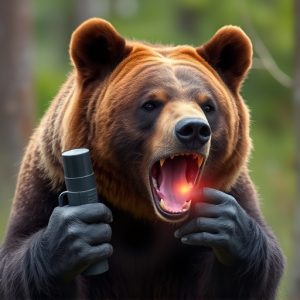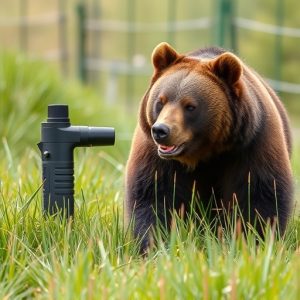Alaska Bear Repellent Range: Understanding Safety vs. Myth
Bear spray is a specialized repellent that offers critical protection against aggressive bears durin…….
Bear spray is a specialized repellent that offers critical protection against aggressive bears during hiking or camping in bear country, though it may not deter all charging grizzlies. With a proven track record of reducing attack risks by irritating bears' sensory systems, it's an essential tool for self-defense, especially against powerful grizzly bears. In Alaska, understanding the maximum range—around 20 feet—and optimal conditions for bear spray use is crucial for hikers and campers to maintain distance from these creatures. The effectiveness of repellents like Guard Alaska bear repellent varies based on weather conditions, terrain, and specific product types, with an average deterrent range of about 20 feet against charging grizzlies.
“In Alaska’s vast wilderness, encountering a charging grizzly bear can be a terrifying reality. Understanding the maximum range of bear repellent, particularly bear spray, is crucial for navigating these potential hazards. This guide delves into the science behind bear spray, its effectiveness against aggressive bears, and practical tips for application. We dispel myths about the spray’s range and provide insights to ensure your safety when facing off against a charging grizzly, empowering you with knowledge in the bear country.”
- Understanding Bear Spray: What It Is and How It Works
- The Power of a Charging Grizzly: Behavior and Hazards
- Comparing Bear Spray Effectiveness: Key Factors to Consider
- Maximizing Your Protection: Application Techniques and Tips
- Alaska's Bear Repellent Range: Myths vs. Reality
Understanding Bear Spray: What It Is and How It Works
Bear spray, also known as bear repellent, is a powerful tool designed to protect individuals from aggressive bears in their natural habitat. It’s an essential item for anyone venturing into bear country, especially when hiking or camping. Unlike what one might think, bear spray isn’t just pepper spray; it’s a specialized formulation tailored to deter bears. When used correctly, it can create a safe distance between the user and the bear, preventing potential attacks.
When facing an approaching grizzly bear, understanding the difference between bear spray and its effectiveness against charging grizzlies is crucial. Bear spray vs. charging grizzly is a topic of interest for many outdoor enthusiasts. While no method is 100% guaranteed, bear spray has proven to be highly effective in reducing attack risks when used appropriately. It works by irritating the bear’s eyes, nose, and respiratory system, temporarily disorienting it and allowing the user an escape route. In contrast, a charging grizzly’s primary goal is to catch and overpower its target, making bear spray a critical tool for self-defense in such situations.
The Power of a Charging Grizzly: Behavior and Hazards
In Alaska, facing a charging grizzly bear is an extremely dangerous scenario. These powerful animals are known for their immense strength and unpredictable behavior, especially when they feel threatened or are protecting their cubs. When faced with a potential predator like a human, bears often react aggressively, which makes understanding their behavior crucial for survival.
Bear spray, a common deterrent among outdoor enthusiasts, is effective against black bears but may not stop a charging grizzly. Grizzlies have been observed to ignore bear spray, especially when they are close and feel the wind is blowing it away from them. Therefore, knowing the maximum range of repellents like Guard Alaska bear repellent is essential for hikers and campers. It empowers individuals to maintain distance and avoid close encounters with these formidable creatures, ensuring their safety in the Alaskan wilderness.
Comparing Bear Spray Effectiveness: Key Factors to Consider
When it comes to protecting yourself from bears, understanding the effectiveness of different repellents is crucial, especially in Alaska’s vast wilderness. Bear spray has long been considered a popular and effective deterrent against both black and grizzly bears. However, when comparing bear spray to a charging grizzly bear, several key factors come into play.
One significant factor is the range of the repellent. Bear spray is designed to be sprayed directly into the bear’s face, temporarily blinding and disorienting it. The maximum effective range for bear spray is typically around 20-30 feet (6-9 meters), but this can vary based on wind conditions and the specific product used. In contrast, a charging grizzly bear’s reach extends much further, allowing it to make contact with its powerful paws from a closer distance. This inherent difference in range suggests that while bear spray can provide crucial seconds for escape or retreat, it might not always be sufficient against an aggressive grizzly bear directly approaching.
Maximizing Your Protection: Application Techniques and Tips
To maximize the protection offered by bear repellent, especially in situations involving charging grizzlies, understanding and employing effective application techniques is paramount. When using bear spray, timing and distance are crucial. Aim for the bear’s face and eyes, as these areas are sensitive, and spray from a safe distance—ideally 20 to 30 feet away. This range ensures you don’t get too close to the bear while still allowing the repellent to take effect.
Practicing proper application techniques can significantly enhance your safety. Keep your spray ready at all times, as bears can charge unexpectedly. When faced with a potential encounter, remain calm and back away slowly while spraying. Crosswind conditions are ideal for optimal coverage, ensuring the spray reaches the bear effectively. Remember, practice makes perfect; familiarize yourself with the spray’s mechanism through regular training to ensure you’re prepared in the event of a real bear meeting.
Alaska's Bear Repellent Range: Myths vs. Reality
In Alaska, the effectiveness of bear repellent ranges is a topic of much debate, especially when comparing bear spray to deterring a charging grizzly. Many myths surround the maximum range of these repellents, leading to misconceptions among visitors and residents alike. The reality is that the range of bear spray varies greatly depending on several factors: weather conditions, terrain, and the specific type of repellent used.
While some sources claim a maximum range of 30 feet for bear spray, this is often an oversimplification. In ideal conditions, where visibility is high and the wind is minimal, this range might hold true. However, in practical scenarios, factors like strong winds or humid conditions can significantly reduce the effective distance. Research suggests that for most bear spray brands, the average deterrent range against a charging grizzly bear is around 20 feet, but it’s crucial to remember this is an average and can vary widely based on real-world variables.
In understanding the dynamics between bear spray and a charging grizzly, it’s clear that the correct usage of bear repellent is crucial for safety in Alaska’s unique environment. By comparing different brands and learning effective application techniques, you can maximize your protection against these powerful animals. Remember, while bear spray isn’t a guarantee against attacks, it significantly improves your chances when faced with a charging grizzly, making it an indispensable tool for outdoor enthusiasts and residents alike in the great Alaskan wilderness. When used correctly, bear spray offers a safer, smarter approach to navigating Alaska’s natural landscape, especially when encountering one of its most formidable inhabitants—the charging grizzly bear.


